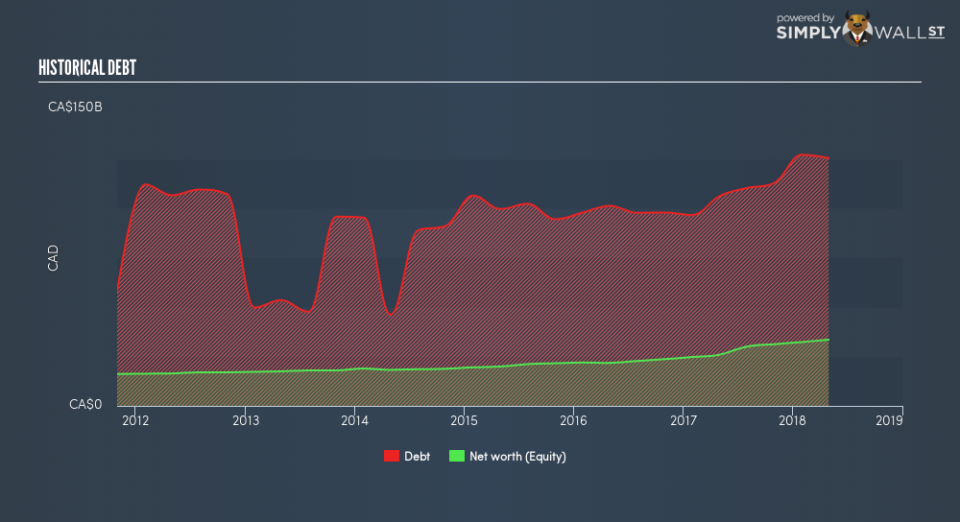Is Canadian Imperial Bank of Commerce’s (TSE:CM) ROE Of 14.63% Sustainable?

This analysis is intended to introduce important early concepts to people who are starting to invest and want to start learning about core concepts of fundamental analysis on practical examples from today’s market.
Canadian Imperial Bank of Commerce (TSE:CM) outperformed the Diversified Banks industry on the basis of its ROE – producing a higher 14.63% relative to the peer average of 13.76% over the past 12 months. On the surface, this looks fantastic since we know that CM has made large profits from little equity capital; however, ROE doesn’t tell us if management have borrowed heavily to make this happen. In this article, we’ll closely examine some factors like financial leverage to evaluate the sustainability of CM’s ROE.
Check out our latest analysis for Canadian Imperial Bank of Commerce
Peeling the layers of ROE – trisecting a company’s profitability
Return on Equity (ROE) weighs Canadian Imperial Bank of Commerce’s profit against the level of its shareholders’ equity. It essentially shows how much the company can generate in earnings given the amount of equity it has raised. Generally speaking, a higher ROE is preferred; however, there are other factors we must also consider before making any conclusions.
Return on Equity = Net Profit ÷ Shareholders Equity
ROE is assessed against cost of equity, which is measured using the Capital Asset Pricing Model (CAPM) – but let’s not dive into the details of that today. For now, let’s just look at the cost of equity number for Canadian Imperial Bank of Commerce, which is 10.00%. This means Canadian Imperial Bank of Commerce returns enough to cover its own cost of equity, with a buffer of 4.63%. This sustainable practice implies that the company pays less for its capital than what it generates in return. ROE can be split up into three useful ratios: net profit margin, asset turnover, and financial leverage. This is called the Dupont Formula:
Dupont Formula
ROE = profit margin × asset turnover × financial leverage
ROE = (annual net profit ÷ sales) × (sales ÷ assets) × (assets ÷ shareholders’ equity)
ROE = annual net profit ÷ shareholders’ equity
Essentially, profit margin shows how much money the company makes after paying for all its expenses. The other component, asset turnover, illustrates how much revenue Canadian Imperial Bank of Commerce can make from its asset base. Finally, financial leverage will be our main focus today. It shows how much of assets are funded by equity and can show how sustainable the company’s capital structure is. Since ROE can be inflated by excessive debt, we need to examine Canadian Imperial Bank of Commerce’s debt-to-equity level. The debt-to-equity ratio currently stands at over 2.5 times, meaning the above-average ratio is a result of a large amount of debt.
Next Steps:
While ROE is a relatively simple calculation, it can be broken down into different ratios, each telling a different story about the strengths and weaknesses of a company. Canadian Imperial Bank of Commerce exhibits a strong ROE against its peers, as well as sufficient returns to cover its cost of equity. Its high debt level means its strong ROE may be driven by debt funding which raises concerns over the sustainability of Canadian Imperial Bank of Commerce’s returns. Although ROE can be a useful metric, it is only a small part of diligent research.
For Canadian Imperial Bank of Commerce, I’ve put together three key aspects you should further examine:
Financial Health: Does it have a healthy balance sheet? Take a look at our free balance sheet analysis with six simple checks on key factors like leverage and risk.
Valuation: What is Canadian Imperial Bank of Commerce worth today? Is the stock undervalued, even when its growth outlook is factored into its intrinsic value? The intrinsic value infographic in our free research report helps visualize whether Canadian Imperial Bank of Commerce is currently mispriced by the market.
Other High-Growth Alternatives : Are there other high-growth stocks you could be holding instead of Canadian Imperial Bank of Commerce? Explore our interactive list of stocks with large growth potential to get an idea of what else is out there you may be missing!
To help readers see past the short term volatility of the financial market, we aim to bring you a long-term focused research analysis purely driven by fundamental data. Note that our analysis does not factor in the latest price-sensitive company announcements.
The author is an independent contributor and at the time of publication had no position in the stocks mentioned. For errors that warrant correction please contact the editor at editorial-team@simplywallst.com.

 Yahoo Finance
Yahoo Finance 

